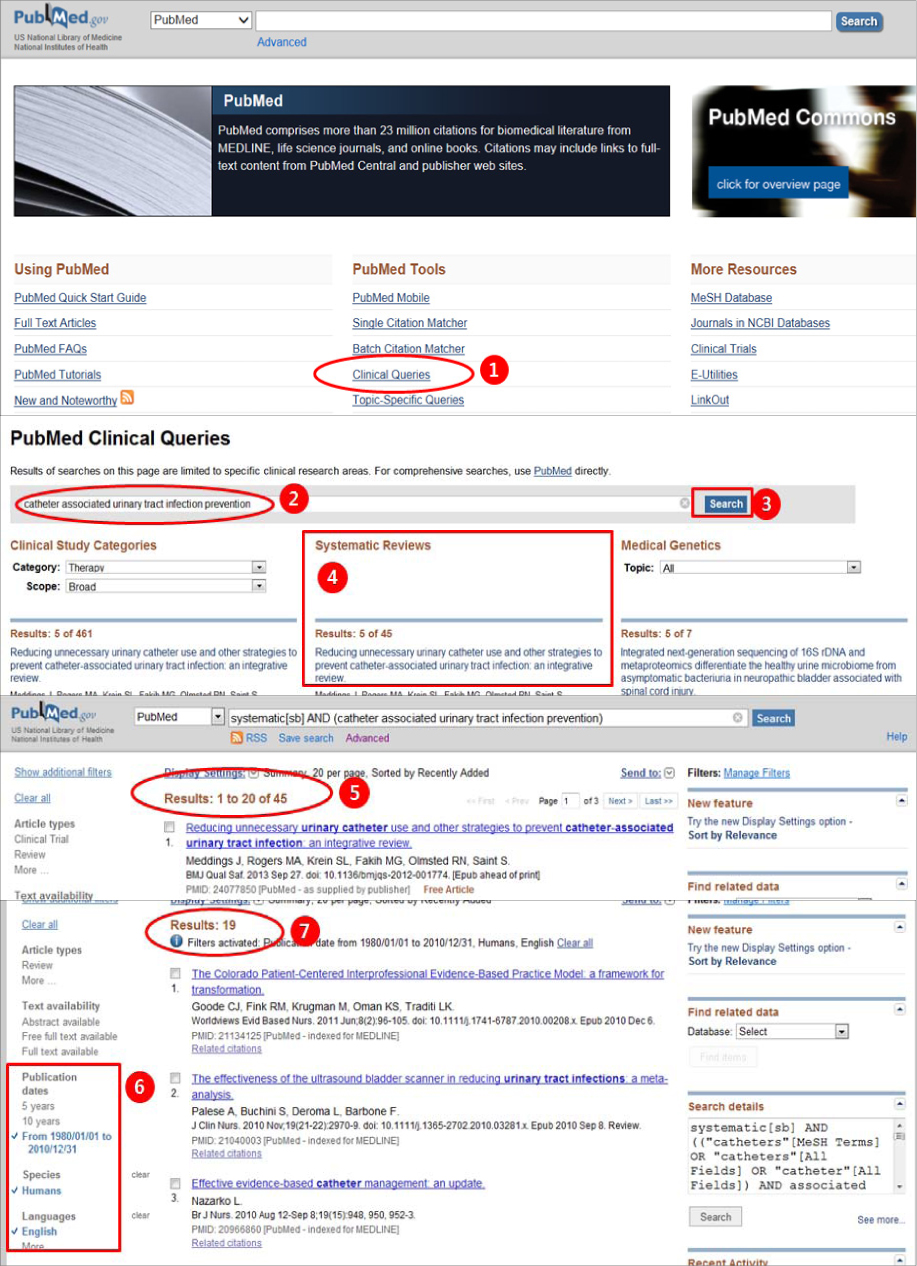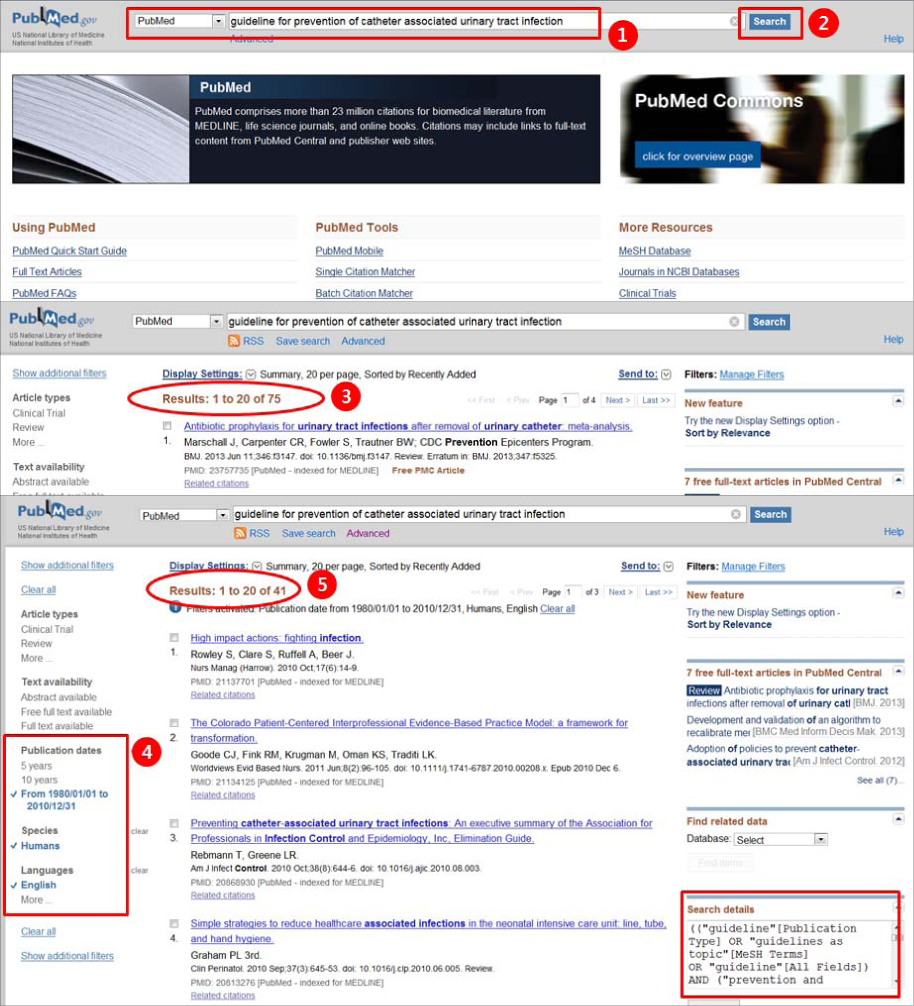J Korean Acad Nurs Adm.
2014 Jan;20(1):128-143.
An Example of Systematic Searching for Guidelines to Prevent Catheter-associated Urinary Tract Infections - Part I: Using the PubMed Database
- Affiliations
-
- 1Department of Nursing, Dongshin University, Korea.
- 2College of Nursing, Chonnam National University, Korea.
- 3Chonnam Research Institute of Nursing Science, Korea.
- 4Department of Nursing, Nambu University, Korea.
- 5Department of Nursing, Mokpo National University, Korea.
- 6Department of Nursing, Honam University, Korea. hypark@honam.ac.kr
Abstract
- PURPOSE
Effective literature searching is essential to support evidence-based nursing. The aim of this study was to present our recent systematic search experience to identify guidelines in PubMed for prevention of catheter-associated urinary tract infections.
METHODS
Five approaches to the literature search via PubMed were employed. The searches were restricted to items published from 1980 to 2010, for patients admitted to hospital, and in the English language. The search results were compared using the number of records and relevant items, and the sensitivity and precision of each search strategy.
RESULTS
The individual approaches retrieved 19-141 of records and 3-6 of relevant items. Sensitivity ranged from 37.5% to 75.0% with the highest values for simple searches and a search combining MeSH terms and free textwords with a methodological search filter. Precision varied from 4.3% to 21.7% and the highest precision was found for MeSH terms with limits feature.
CONCLUSION
The simple search in PubMed is an appropriate way for nurses in a busy clinical practice to search the literature for evidence. However, several approaches using MeSH terms, free textwords, limits feature or methodological search filters are also required to have more efficient and better informed search results.
Keyword
MeSH Terms
Figure
Reference
-
1. Bartels EM. How to perform a systematic search. Best Pract Res Clin Rheumatol. 2013; 27:295–306. http://dx.doi.org/10.1016/j.berh.2013.02.001.2. Coneway LJ, Larson EL. Guidelines to prevent catheter-associated urinary tract infection: 1980 to 2010. Heart Lung. 2012; 41:271–283. http://dx.doi.org/10.1016/j.hrtlng.2011.08.001.3. Doig GS, Simpson F. Efficient literature searching: A core skill for the practice of evidence-based medicine. Intensive Care Med. 2003; 29:2119–2127. http://dx.doi.org/10.1007/s00134-003-1942-5.4. Ehrlich-Jones L, O'Dwyer L, Stevens K, Deutch A. Searching the literature for evidence. Rehabil Nurs. 2008; 33:163–169. http://dx.doi.org/10.1002/j.2048-7940.2008.tb00222.x.5. Fraser C, Murray A, Burr J. Identifying observational studies of surgical interventions in MEDLINE and EMBASE. BMC Med Res Methodol. 2006; 6:41. http://dx.doi.org/10.1186/1471-2288-6-41.6. Gould CV, Umscheid CA, Agarwal RK, Kuntz G, Pegues DA. Healthcare Infection Control Practices Advisory Committee. Guideline for prevention of catheter-associated urinary tract infections 2009. Infect Control Hosp Epidemiol. 2010; 31:319–326.7. Gu MO, Eun Y, Kim SM, Chung JS, Park MH, Park MS, et al. Evidence-based practice in nursing & healthcare. Seoul: Fornursebook;2013.8. Gu EO, Cho MS, Cho YA, Jeong JS, Jeong IS, Park JS, et al. Topics for evidence-based clinical nursing practice guidelines in Korea. J Korean Clin Nurs Res. 2011; 17:307–318.9. Haig A, Dozier M. BEME Guide No. 3: Systematic searching for evidence in medical education-Part 2: Constructing searches. Med Teach. 2003; 25:463–484. http://dx.doi.or/10.1080/01421590310001608667.10. Hooton TM, Bradley SF, Cardenas DD, Colgan R, Geerlings SE, Rice JC, et al. Diagnosis, prevention, and treatment of catheter-associated urinary tract infection in adults: 2009 international clinical practice guidelines from the Infectious Diseases Society of America. Clin Infect Dis. 2010; 50:625–663.11. Kim SY, Park JE, Seo HJ, Lee YJ, Jang BH, Son HJ, et al. NECA's guidance for understanding systematic reviews and meta-analyses for intervention. Seoul: National Evidence-based Healthcare Collaborating Agency;2011.12. Lee SO, Kim ES, Kim HY, Park ES, Jin HY, Ki HK, et al. Korean nosocomial infections surveillance system, intensive care unit module report: Data summary from July 2007 through June 2008. Korean J Nosocomial Infect Control. 2008; 13:69–82.13. Lindsey WT, Olin BR. PubMed searches: Overview and strategies for clinicians. Nutr Clin Pract. 2013; 28:165–176. http://dx.doi.org/10.1177/0884533613475821.14. Lo E, Nicolle L, Classen D, Arias KM, Podgorny K, Anderson DJ, et al. Strategies to prevent catheter-associated urinary tract infections in acute care hospitals. Infect Control Hosp Epidemiol. 2008; 29:Suppl. 1. S41–S50.15. Motschall E, Falck-Ytter Y. Searching the MEDLINE literature database through PubMed: A short guide. Onkologie. 2005; 28:517–522. http://dx.doi.org/10.1159/000087186.16. Murphy SA. Applying methodological search filters to CAB Abstracts to identify research for evidence-based veterinary medicine. J Med Libr Assoc. 2002; 90:406–410.17. Park MH. Understanding and application of evidence based nursing. Seoul: Goonja;2006.18. Parker D, Callan L, Harwood J, Thompson DL, Wilde M, Gray M. Nursing interventions to reduce the risk of catheter-associated urinary tract infection. Part 1: Catheter selection. J Wound Ostomy Continence Nurs. 2009; 36:23–34.19. Parker D, Callan L, Harwood J, Thompson D, Webb ML, Wilde M, et al. Catheter-associated urinary tract infections: fact sheet. J Wound Ostomy Continence Nurs. 2009; 36:156–159.20. Pratt RJ, Pellowe C, Loveday HP, Robinson N, Smith GW, Barrett S, et al. The EPIC Project: Developing national evidence-based guidelines for preventing healthcare associated infections. Phase I: Guidelines for preventing hospital-acquired infections. Department of Health (England). J Hosp Infect. 2001; 47:Suppl. S3–S82.21. Pratt RJ, Pellowe CM, Wilson JA, Loveday HP, Harper PJ, Jones SR, et al. EPIC 2: National evidence-based guidelines for preventing healthcare-associated infections in NHS hospitals in England. J Hosp Infect. 2007; 65:Suppl. 1. S1–S64.22. Richter RR, Austin TM. Using MeSH (medical subject headings) to enhance PubMed search strategies evidence-based practice in physical therapy. Phys Ther. 2012; 92:124–132. http://dx.doi.org/10.2522/?ptj.20100178.23. Sampson M, McGowan J. Errors in search strategies were identified by type and frequency. J Clin Epidemiol. 2006; 59:1057–1063. http://dx.doi.org/10.1016/j.jclinepi.2006.01.007.24. Sampson M, McGowan J, Lefebvre C, Moher D, Grimshaw J. PRESS: Peer review of electronic search strategies. Ottawa: Canadian Agency for Drugs and Technologies in Health;2008.25. Schaafsma F, Hulshof C, Verbeek J, Bos J, Dyserinck H, Dijk FV. Developing search strategies in Medline on the occupational origin of diseases. Am J Ind Med. 2006; 49:127–137. http://dx.doi.org/10.1002/ajim.20235.26. Scottish Intercollegiate Guidelines Network. Search filters. 2013. Retrieved November 16, 2013. from http://www.sign.ac.uk/methodology/filters.html.27. Sladek RM, Tieman J, Currow DC. Improving search filter development: A study of palliative care literature. BMC Med Inform Decis Mak. 2007; 7:18. http://dx.doi.org/10.1186/1472-6947-7-18.28. Sladek R, Tieman J, Fazekas BS, Abernethy AP, Currow DC. Development of a subject search filter to find information relevant to palliative care in the general medical literature. J Med Libr Assoc. 2006; 94:394–401.29. Son YJ, Kim SH, Park YS, Lee SK, Lee YM. The influence of information retrieval skill on evidence based practice competency in clinical nurses. Korean J Adult Nurs. 2012; 24:635–646. http://dx.doi.org/10.7475/kjan.2012.24.6.635.30. Stillwell SB, Fineout-Overholt E, Melnyk BM, Williams K. Evidence-based practice, step by step: Searching for the evidence. Am J Nurs. 2010; 110(5):41–47. http://dx.doi.org/10.1097/01.NAJ.0000372071.24134.7e.31. Tenke P, Kovacs B, Bjerklund Johansen TE, Matsumoto T, Tambyah PA, Naber KG. European and Asian guidelines on management and prevention of catheter-associated urinary tract infections. Int J Antimicrob Agents. 2008; 31:Suppl. 1. S68–S78.32. University of Texas School of Public Health. Search filters for various databases. 2010. Retrieved November 16, 2013. from http://libguides.sph.uth.tmc.edu/pubmed_filters.33. Willson M, Wilde M, Webb ML, Thompson D, Parker D, Harwood J, et al. Nursing interventions to reduce the risk of catheter-associated urinary tract infection: Part 2: Staff education, monitoring, and care techniques. J Wound Ostomy Continence Nurs. 2009; 36:137–154.34. Winters CA, Echeverri R. Teaching strategies to support evidence-based practice. Crit Care Nurse. 2012; 32(3):49–54. http://dx.doi.org/10.4037/ccn2012159.35. Wong ES. Guideline for prevention of catheter-associated urinary tract infections. Am J Infect Control. 1983; 11:28–36.
- Full Text Links
- Actions
-
Cited
- CITED
-
- Close
- Share
- Similar articles
-
- Systematic Search for Guidelines to Prevent Catheter-associated Urinary Tract Infections-Part II: Using the Ovid MEDLINE
- Catheter-associated Urinary Tract Infection
- Management of urinary tract infection in geriatric hospital patients
- Spontaneous Bladder Perforation in a Patient with a Long-Term Intraurethral Catheter
- Incidence of Catheter-associated Urinary Tract Infection in Hospitals with Less than 300 Beds




